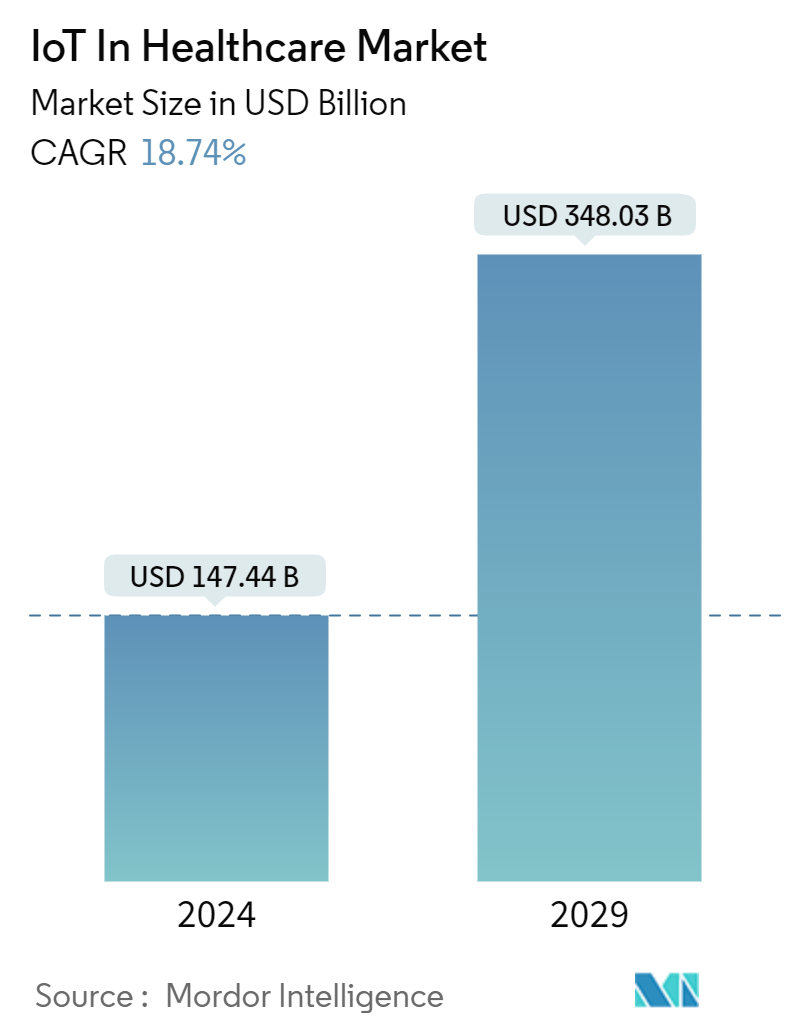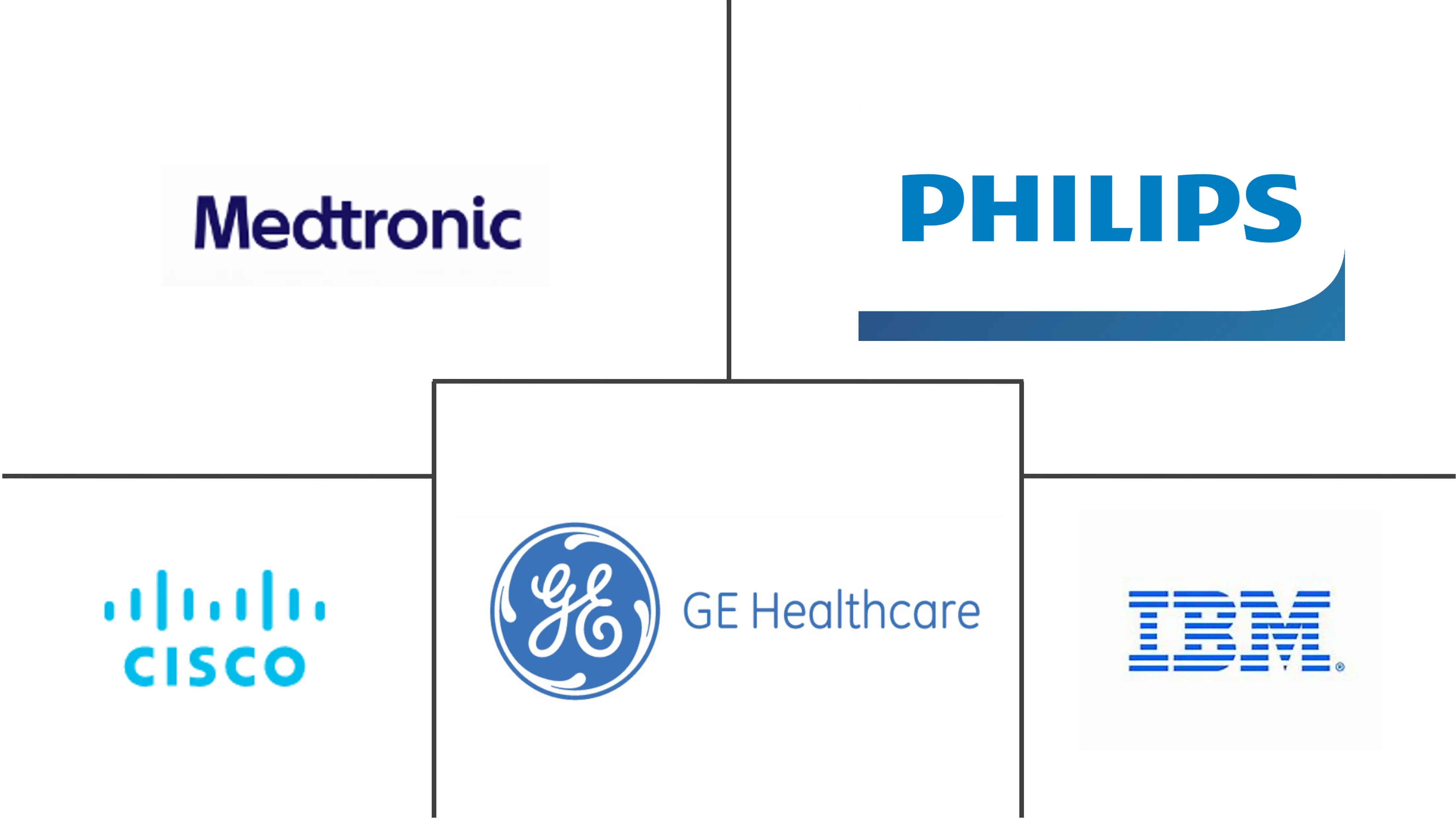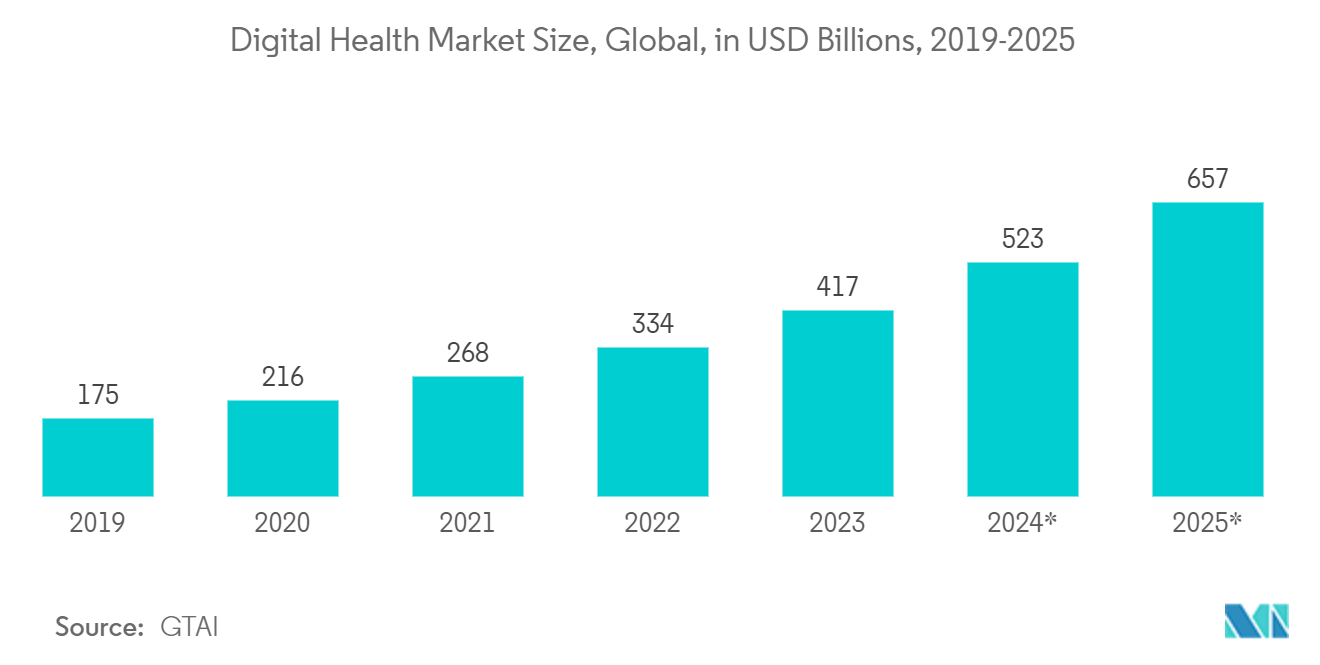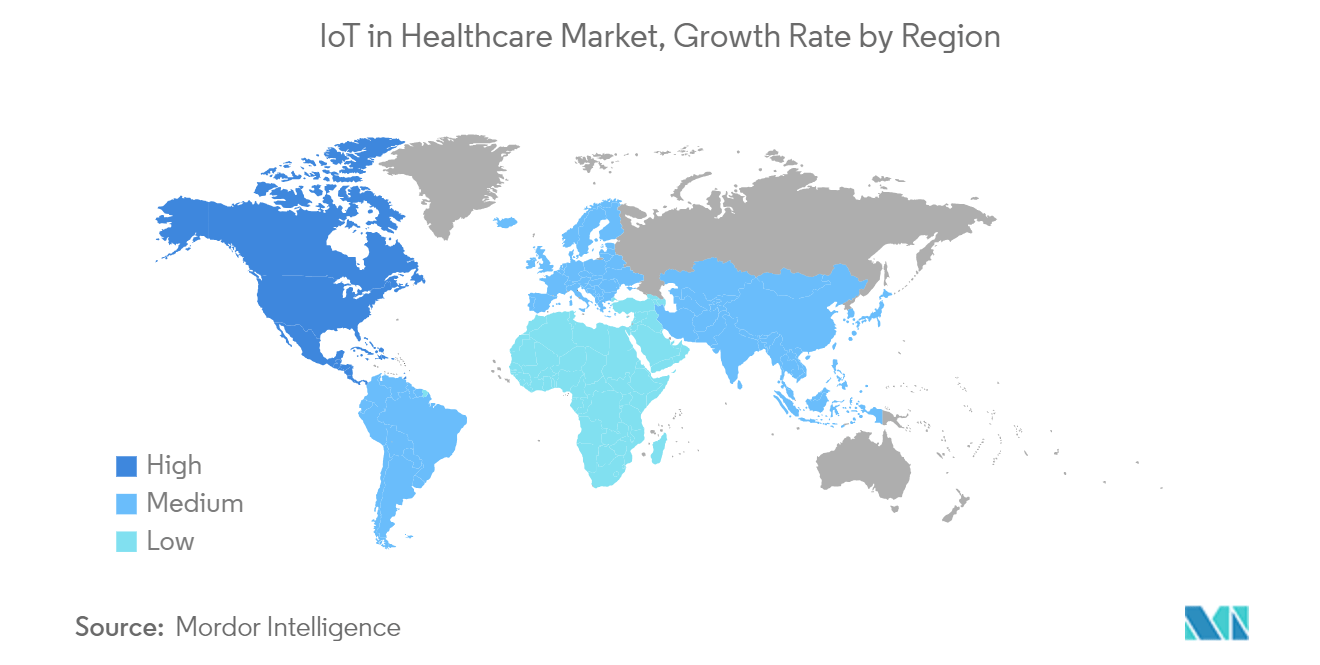Internet of Things (IoT) in Healthcare Market Size

| Study Period | 2019 - 2029 |
| Market Size (2024) | USD 147.44 Billion |
| Market Size (2029) | USD 348.03 Billion |
| CAGR (2024 - 2029) | 18.74 % |
| Fastest Growing Market | Asia Pacific |
| Largest Market | North America |
Major Players
*Disclaimer: Major Players sorted in no particular order |
Internet of Things (IoT) in Healthcare Market Analysis
The IoT In Healthcare Market size is estimated at USD 147.44 billion in 2024, and is expected to reach USD 348.03 billion by 2029, growing at a CAGR of 18.74% during the forecast period (2024-2029).
The IoT market is driven by the growing adoption of healthcare information systems, the emergence of big data in healthcare, improved device accuracy and connectivity, and the increasing penetration of connected devices in healthcare.
- IoT technology has the potential to revolutionize traditional paper-based healthcare treatment by simplifying access to remote patient monitoring and real-time patient data. The emergence of this digital healthcare technology has addressed the impending need for better diagnostics and targeted therapeutic tools. In addition, it provides remote patient monitoring to physicians and works as a fitness and wellness tracker for athletes and a dosing reminder for patients. The successful implementation of IoT in the remote monitoring of asthma and diabetes patients, coupled with the high penetration of fitness and wellness devices, has created a high demand for the IoT healthcare market.
- Big data analytics is a fast-emerging topic in IoT. The demand for big data analytics integrates the most recent innovation in machine learning, logical methodologies, computational intelligence, and data mining. Many healthcare experts, including payers and providers, are now analyzing big data to obtain detailed knowledge. Even though these efforts are still in their early stages, they are expected to collectively help tackle the industry-related problems regarding inconsistency in healthcare quality and escalating healthcare expenditures. Organizations might leverage big data approaches and solutions to engage patients, personalize care, lower costs and variability, and enhance the quality of service.
- The market is driven by rising digital adoption in the healthcare industry. The healthcare sector has grown enormously due to technological advancements, digitization of healthcare, and government participation. Trends that have arisen throughout this stage have enabled modern technology to simplify further and enhance the patient experience. Nowadays, almost every element of healthcare uses technology like machine learning, automation, and artificial intelligence (AI). As a way to help doctors make more accurate diagnoses, AI and ML tools are becoming increasingly common.
- Artificial intelligence is a powerful tool that can increase the efficiency, speed, and effectiveness of the global health system. It has the potential to improve the efficiency of telemedicine. Researchers at UCLA have combined chatbot technology and an AI system to create a virtual interventional radiologist (VIR), which helps the patient self-diagnose or the doctor diagnose the patient.
- With the help of IoT, patients can convert their personal health information, such as the number of steps taken, vital signs, and calories burned, into non-personally identifiable information on the platform and store it safely, further supporting the data analysis and R&D activities of pharmaceutical companies and medical institutions to accelerate the development of medical devices and discovery of new drugs.
- Improvements in the quality of people's daily health and life activities, as well as big data analytics to support and promote such research activities, are some of the factors driving the market's growth, as IoT-based healthcare systems play a key role in the development of medical information systems. Tracking, tracing, and monitoring patients are essential to enhance the healthcare system.
- Market growth is projected to be restrained by difficulties such as the high costs of IoT infrastructure development, privacy and security concerns about data, a general lack of awareness among underdeveloped countries' populations, and a lack of technical expertise.
Internet of Things (IoT) in Healthcare Market Trends
Increased Digital Adoption in the Healthcare Sector
- Growth in digital health adoption improves engagement with the healthcare system. The survey conducted by Accenture Health and Life Sciences Experience in the United States in 2021 reveals that 26 percent of people said healthcare system access had improved than during the pandemic. Digital adoption spiked overnight as providers had to pivot to virtual care quickly.
- The public and private healthcare industries have adopted digital technology at a considerably higher rate due to the pandemic. A few of the cohort's start-ups have also proved crucial to pandemic management. Blackfrog Technologies has created solutions for temperature-regulated vaccine carriers, allowing them to deploy in specific areas of Rajasthan. ThermaiScan, a Swedish solution, has developed a solution to screen for breast cancer through mobile phones, which showcases the increased demand for digital technologies in the healthcare sector.
- Several regional governments are taking the initiative and making investments to support digital adoption in the healthcare industry. For instance, in June 2022, the European government announced investing EUR 150 million to enable digital healthcare transformation, ranging from virtual wards to phone vaccine records. The plan includes supporting the introduction of electronic medical records in all NHS trusts and helping more than half a million people manage their long-term health problems from the comfort of their homes using digital tools.
- Similarly, in India, the government has taken initiatives like National Digital Health Mission, Ayushman Bharat Digital Mission, and Make in India to accelerate innovation and digitization in the country's healthcare sector.
- The medication management segment is also expected to show significant growth due to the growing adoption of healthcare information systems, the rising need to reduce medication errors and improve patient safety, and the increasing adoption of mHealth solutions for medication management. A rising focus of market players on developing innovative solutions in the field of medication management is also boosting the segment's growth.
- With the development of digital technologies, such as artificial intelligence and machine learning, which have massive potential in the market for healthcare, hospitals and other medical institutions can treat more patients at once while significantly lowering their workload.
- AI can assist medical professionals in giving more precise diagnoses and treatment plans using patient data and other information. AI can also help make healthcare more proactive and predictive by analyzing extensive data to create better patient preventative care suggestions.
- Devices supporting the Internet of Things (IoT) have enabled remote medical monitoring, keeping patients safe and healthy and expanding the possibilities for doctors to deliver world-class care. It also improved patient engagement and satisfaction by making interactions with doctors easier and more efficient. In addition, remote patient health monitoring can help reduce hospital stays and prevent readmissions. IoT will also have a major impact on dramatically reducing healthcare costs and improving patient outcomes.

North America Holds the Largest Market Share of IoT in Healthcare Market
- The Internet of Things (IoT) in the healthcare market in North America dominates the overall market and is expected to show similar trends during the forecast period. This growth is due to the increasing adoption of healthcare IT solutions, major players' presence, and sophisticated infrastructure availability.
- Remote monitoring is now possible due to IoT-enabled devices across the region. It keeps patients healthy and safe and expands the possibilities for doctors to deliver superior care. Improved doctor-patient communications have also resulted in improved patient involvement and satisfaction rates. The hospital stay is shortened, and readmission is avoided because of remote patient monitoring.
- The use of EHRs (Electronic Health Records) has reached its full potential throughout North America, particularly in the United States. Numerous companies are out front in the IoT and healthcare sectors, aiming to capture a significant market share by creating solutions for particular medical applications, expanding collaborative R&D, and acquiring new startups. Particularly in the United States, healthcare IT firms are experiencing successful, revolutionary, and innovative advantages by providing services.
- By incorporating intelligence into medical devices, monitoring has become a primary focus in this region. For instance, the FDA approved using Epitel's initial product, a wireless and wearable EEG sensor for monitoring brain waves, in hospital emergency rooms and critical care units in 2021. This gadget provides real-time data insights about patients.
- Leading players operating in the market are focusing on strategic collaborations to support the adoption of digitalization in the healthcare sector. For instance, in September 2022, Honeywell International Inc. announced collaborations with two leading healthcare companies to follow in the United States and worldwide. The company will provide advanced digital technology and sensors to improve patient outcomes and increase connectivity for more efficient monitoring in homes and hospitals.
- Rising initiatives to reduce medical costs, security of data transfer on health IoT devices, and a transition from fee-for-service to a value-based approach have all significantly boosted the market. In February 2022, the government introduced bipartisan legislation, S.3620, the Health Data Use and Privacy Commission Act, to establish a commission and analyze the potential healthcare-related privacy threats.

Internet of Things (IoT) in Healthcare Industry Overview
The Internet of Things (IoT) in the healthcare market is moderately competitive and consists of several major players. The companies are implementing specific strategic initiatives, such as mergers, new product launches, acquisitions, and partnerships, which help them strengthen their market positions. The key players in this market are Medtronic, GE Healthcare, Koninklijke Philips NV, Honeywell Life Care Solutions, and Biotronik.
- In March 2023, Fujitsu announced to launch a new cloud-based platform that allows users to securely collect and leverage health-related data and promote digital transformation in the medical sector. The new platform enables the automatic conversion of medical data from electronic medical records of medical institutions that conforms to the next-generation standard framework HL7 FHIR (1) and the secure aggregation of health-related data.
- In March 2023, Microsoft announced the introduction of the new Dragon Ambient eXperience (DAX) express to automate clinical documentation at scale. DAX Express is a clinical documentation application integrated into automated workflows that, for the first time, combines proven conversational and environmental AI with the advanced reasoning and natural language capabilities of OpenAI's GPT-4.
Internet of Things (IoT) in Healthcare Market Leaders
-
Medtronic PLC
-
Koninklijke Philips NV
-
Cisco Systems
-
International Business Machines Corporation (IBM)
-
GE Healthcare
*Disclaimer: Major Players sorted in no particular order
 in Healthcare Market pic4.png)
Internet of Things (IoT) in Healthcare Market News
- March 2023- NVIDIA announced a strategic collaboration with Medtronic to accelerate the development of AI in the healthcare system and bring new AI-based solutions into patient care. The companies will integrate NVIDIA healthcare and edge AI technologies into Medtronic's GI Genius intelligent endoscopy module, designed and manufactured by Cosmo Pharmaceuticals. GI Genius is the first FDA-cleared AI-powered colonoscopy tool to help physicians identify polyps that may lead to colon cancer.
- September 2022 - Wipro GE Healthcare launched an AI-powered cath lab called Optima IGS320. It improves imaging vision to facilitate intelligence and accurate healthcare delivery. Social gantry movement allows for flexibility during surgeries, further lightening the load and increasing the attention of the doctors.
Internet of Things (IoT) in Healthcare Market Report - Table of Contents
1. INTRODUCTION
- 1.1 Study Assumptions and Market Definitions
- 1.2 Scope of the Study
2. RESEARCH METHODOLOGY
3. EXECUTIVE SUMMARY
4. MARKET INSIGHTS
- 4.1 Market Overview
- 4.2 Industry Value Chain Analysis
-
4.3 Industry Attractiveness - Porter's Five Forces Analysis
- 4.3.1 Threat of New Entrants
- 4.3.2 Bargaining Power of Buyers/Consumers
- 4.3.3 Bargaining Power of Suppliers
- 4.3.4 Threat of Substitute Products
- 4.3.5 Intensity of Competitive Rivalry
- 4.4 Assessment of COVID-19 Impact on the market
5. MARKET DYNAMICS
-
5.1 Emergence of Big Data in Healthcare
- 5.1.1 Increased IT Adoption in the Healthcare Sector
- 5.1.2 Improved Device Accuracy and Connectivity
-
5.2 Market Restraints
- 5.2.1 Data Privacy and Security Concerns
- 5.2.2 Requirement for High Initial Investments
6. MARKET SEGMENTATION
-
6.1 Component
- 6.1.1 Medical Devices
- 6.1.1.1 Wearable External Medical Devices
- 6.1.1.2 Implanted Medical Devices
- 6.1.1.3 Stationary Medical Devices
- 6.1.2 Systems and Software
- 6.1.3 Services
-
6.2 Application
- 6.2.1 Telemedicine
- 6.2.2 Inpatient Monitoring
- 6.2.3 Medication Management
- 6.2.4 Other Applications
-
6.3 End User
- 6.3.1 Hospitals, Clinical Research Organizations, Other End Users
- 6.3.2 Clinical Research Organizations
- 6.3.3 Other End Users
-
6.4 Geography***
- 6.4.1 North America
- 6.4.1.1 United States
- 6.4.1.2 Canada
- 6.4.2 Europe
- 6.4.2.1 United Kingdom
- 6.4.2.2 Germany
- 6.4.2.3 France
- 6.4.3 Asia
- 6.4.3.1 China
- 6.4.3.2 Japan
- 6.4.3.3 India
- 6.4.4 Australia and New Zealand
- 6.4.5 Latin America
- 6.4.6 Middle East and Africa
7. COMPETITIVE LANDSCAPE
-
7.1 Company Profiles*
- 7.1.1 Medtronic PLC
- 7.1.2 Koninklijke Philips NV
- 7.1.3 Cisco Systems
- 7.1.4 International Business Machines Corporation
- 7.1.5 GE Healthcare
- 7.1.6 Microsoft Corporation
- 7.1.7 SAP SE
- 7.1.8 Capsule Technologies Inc.
- 7.1.9 Resideo Technologies Inc.
- 7.1.10 Stanley Healthcare
8. INVESTMENT ANALYSIS
9. MARKET OPPORTUNITIES AND FUTURE TRENDS
** Subject To AvailablityInternet of Things (IoT) in Healthcare Industry Segmentation
As per the scope of this report, IoT in the healthcare system context refers to every device connected to the internet for a wide range of applications, such as tracking patients or equipment, gathering data, and analyzing the received data. The study analyzes market trends and outlines the IoT in the healthcare industry.
The Internet of Things (IoT) in the healthcare market is segmented by component (medical devices, systems and software, services), application (telemedicine, inpatient monitoring, medication management, other applications), end user, and geography.
| Component | Medical Devices | Wearable External Medical Devices |
| Implanted Medical Devices | ||
| Stationary Medical Devices | ||
| Component | Systems and Software | |
| Services | ||
| Application | Telemedicine | |
| Inpatient Monitoring | ||
| Medication Management | ||
| Other Applications | ||
| End User | Hospitals, Clinical Research Organizations, Other End Users | |
| Clinical Research Organizations | ||
| Other End Users | ||
| Geography*** | North America | United States |
| Canada | ||
| Geography*** | Europe | United Kingdom |
| Germany | ||
| France | ||
| Geography*** | Asia | China |
| Japan | ||
| India | ||
| Geography*** | Australia and New Zealand | |
| Latin America | ||
| Middle East and Africa |
Internet of Things (IoT) in Healthcare Market Research FAQs
How big is the IoT In Healthcare Market?
The IoT In Healthcare Market size is expected to reach USD 147.44 billion in 2024 and grow at a CAGR of 18.74% to reach USD 348.03 billion by 2029.
What is the current IoT In Healthcare Market size?
In 2024, the IoT In Healthcare Market size is expected to reach USD 147.44 billion.
Who are the key players in IoT In Healthcare Market?
Medtronic PLC, Koninklijke Philips NV, Cisco Systems, International Business Machines Corporation (IBM) and GE Healthcare are the major companies operating in the IoT In Healthcare Market.
Which is the fastest growing region in IoT In Healthcare Market?
Asia Pacific is estimated to grow at the highest CAGR over the forecast period (2024-2029).
Which region has the biggest share in IoT In Healthcare Market?
In 2024, the North America accounts for the largest market share in IoT In Healthcare Market.
What years does this IoT In Healthcare Market cover, and what was the market size in 2023?
In 2023, the IoT In Healthcare Market size was estimated at USD 119.81 billion. The report covers the IoT In Healthcare Market historical market size for years: 2019, 2020, 2021, 2022 and 2023. The report also forecasts the IoT In Healthcare Market size for years: 2024, 2025, 2026, 2027, 2028 and 2029.
Medical IoT Industry Report
Statistics for the 2024 Medical IoT market share, size and revenue growth rate, created by Mordor Intelligence™ Industry Reports. Medical IoT analysis includes a market forecast outlook to 2029 and historical overview. Get a sample of this industry analysis as a free report PDF download.



